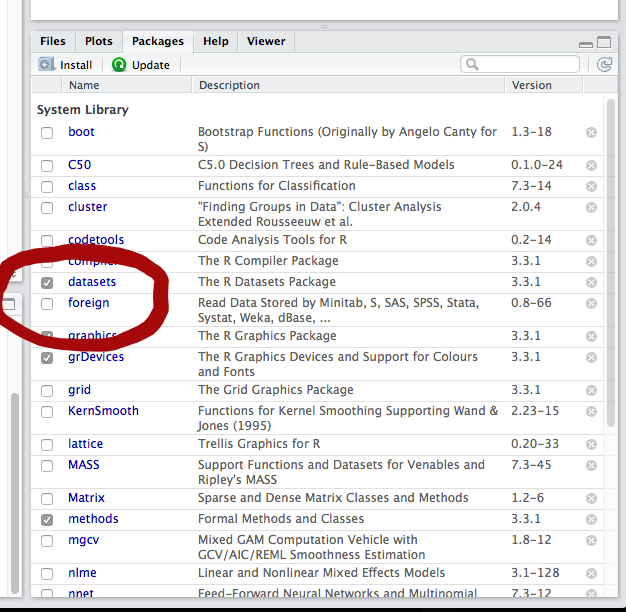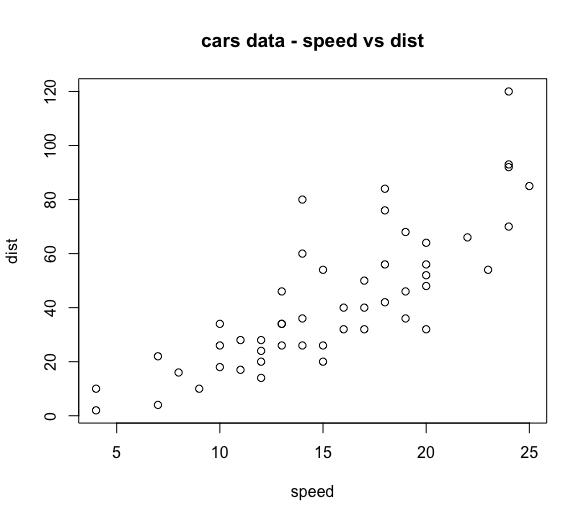Read
data into R
One of the advantages of R when compared to a sophisticated programmable
calculator is that you can import data into R for analysis and
manipulation. The data import functions avoid all of the keyboard entry
and its potential for entry errors.
The
default R datasets included in the base R distribution
The first way to import data into your R session is by using the default
datasets package already included in the base R installation. If you
look at the package listing in the Packages panel, you will find a
package called datasets.
Simply check the checkbox next to the package name to load the package
and gain access to the datasets. You can also click on the package name
and RStudio will open a help file describing the datasets in this
package.
Working through an example with one of the datasets may help you see the
potential of this resource. Check the package checkbox and load the
package. Now, click the package name and browse the datasets package
help file. View the details on the cars dataset [click the dataset name
to view the dataset details]. Type cars at the Command console prompt. R
will output the contents of the cars dataset [50 pairs of values with
the column headings of speed and dist]. Enter this command
plot(cars, main = "cars data -
speed vs dist")
and press ENTER. R plots a scatter plot of the cars dataset with
the speed variable as the x-axis and the dist variable as the y-axis as
shown below.
While you can treat the dataset name of these package datasets as R
objects, as we did in the example above, it is not advisable to do that.
Usually, you will want to manipulate the data and save your results. The
best way to begin using one of the datasets in this package is to assign
its values to an object and then work with that object and not the
dataset. Here is an example:
c <- cars
plot(c, main = "cars data -
speed vs dist")
This will produce the same plot as before, but now you can manipulate
the data in the object c without modifying the default dataset.
Read
an R dataset
Another type of dataset you may encounter is an R dataset. These are
datasets created in R and saved with a .RData
extension. R saves the data in a binary format. This format saves
storage space but restricts usage exclusively to the R environment.
Assuming that you have an R data file named MyData.RData in your
default file folder, you can load the file into an R object with this
command:
load('MyData.RData')
The dataset is now loaded into your R session and ready for you to work
with. RData datasets automatically create a storage object. Look in your
Environment Pane to find the name of the loaded dataset. Notice that the
R data file name is enclosed in quotes [either single or double quotes
are acceptable]. If you forget the quotes, R will respond with an error
message. The load( ) function is case sensitive, so be aware of the
capital letters in your file name.
Read
a text file
Many datasets you may encounter will be stored as text files. One reason
many datasets are stored as text files is because the data can be used
in any application with minimal issues. You can open, view, and edit
text files using a text editor or Excel. R has built in functions to
read text files into your session so they are easy to import into R. The
read.table( ) function will read most text files into
your R session. The only issue with this function is that you have to
tell it several pieces of information about your dataset so that it can
import the data correctly.
Assume that you have a text dataset named MyData.txt that
contains this data:
x, y, z
43, 13, 5
38, 12, 3
40, 14, 6
41, 12, 4
43, 13, 5
You can import this data into an object named example using
this command:
example <-
read.table('MyData.txt', header = TRUE, sep = ",")
This function has three arguments. The first argument identifies the
name of the file that you want to read into R enclosed in quotes. The
second argument tells the function that your file has a header. In this
example you have a header consisting of the names x, y,
and z. The third argument tells the function what
symbol is used to separate the data elements. In this example you have
commas as the separator symbol.
This is a good place to discuss separator symbols. Most text files use
some standard separators. These include a space character, or a tab
character, or a comma character. Each row of data ends in a new line
character. Some text files use other separator characters, but these are
rare and will be addressed later. The example above uses commas. You
communicate that to read.table( ) using the sep
= argument. You enclose the separator symbol in quotes. If
the separator symbol is a space character, or a tab character, you would
use a space enclosed in quotes, like this: sep = " ".
While you can use either single or double quotes around your separator
character, double quotes are clearer when you indicate a space character
for your separator. The read.table( ) function is case
sensitive, so be aware of the capital letters in your file name.
Normally, the read.table( ) function is used for space
or tab separated files because R includes specialized functions for many
other separator types and those specialized functions are usually used
in those cases.
Read
a csv file
One common type of text file you may encounter is a comma
separated or .csv file. In this text file
format the individual data elements are separated with commas.
Additionally, each row of data is divided by line returns. While the MyData.txt
example above is a comma separated data file, it does not conform to the
accepted file name standard. Normally, coma separated text files use a
.csv file name extension. These text files use this special file
name extension because comma separated files are used so often that many
applications, including R, have dedicated functions to import the data
from a .csv file into the application storage and the special file name
extension helps trigger these import functions.
You can import a csv file in R with the command:
ir <-
read.csv('Iris_Data.csv')
Your data will now be in the object ir ready for you to work with.
Notice that, as with the load( ) and read.table( ) functions above, the
R data file name is enclosed in quotes [either single or double quotes
are acceptable]. If you forget the quotes, R will respond with an error
message. The read.csv( ) function is case sensitive, so be aware
of the capital letters in your file name.
Other
input file types
One of the advantages of R being an open source application is that
users can develop functions for specialized needs and make them
available for others to use. Many data file import functions exist for
specialized file types. There are several variations of read.___( )
that can read specialized file formats such as dcf, fwf [fixed-width
format], and DIF. You can install R packages with functions that read
Excel files, javascript JSON files, XML data, HTML files, or directly
from websites. There are R packages that enable you to directly import
data from files produced by proprietary analysis applications such as
SPSS, SAS, Stata, Systat, or Minitab. You can even read data into R from
many database systems. There are few limitations in R on your potential
of data sources for your analytical needs.


